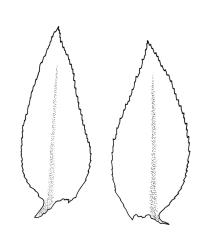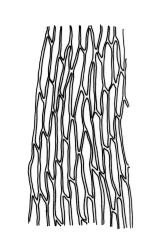Plants yellow-green, lustrous, forming interwoven mats on soil. Stems to c. 25 mm long, densely and irregularly branched, not terete. Branches mostly short and simple, 5–7(–10) mm, not or weakly complanate in N.Z. material. Stem leaves broadly ovate and acute, narrowed to insertion but not cordate, nearly flat, neither plicate nor decurrent, coarsely serrulate throughout, with a stout costa that lacks a terminal spine, c. 1 mm × 0.5 mm; mid laminal cells narrowly rhombic, firm-walled, smooth, mostly 30–45 × 6–9 μm; cells at apex shorter; alar cells differentiated, forming a medium-sized group, subquadrate to short oblong-rectangular, merging gradually with laminal cells. Branch leaves differentiated, spreading, smaller and more narrowly ovate, ± evenly tapered to an acute apex, with a stout costa only weakly tapering above and ending with a prominent abaxial spine, coarsely serrulate throughout, not or very weakly complanate, mostly 0.8–0.9 × 0.3–0.4 mm; mid laminal cells as per stem leaves, the cells at leaf apex markedly shorter and more rhombic; alar cells moderately differentiated, those at extreme corners ± oblong-rectangular and firm-walled.
Reportedly phyllodioicous. Perichaetia scattered on stems, with perichaetial leaves ecostate and widely spreading. Perigonia not seen in N.Z. material. Setae elongate, smooth. Operculum long-rostrate (only one seen in N.Z. material).
Crum & Anderson 1981, fig. 524; Buck 1998, pl. 96, figs 11–18.
NI: Wellington (Somes I.). Known from a single N.Z. collection.
Presumably adventive. Widespread in the northern hemisphere.
The sole collection was from track-side soil in coastal scrub of Corynocarpus laevigatus at 30 m elev. The restriction of this rather characterless (at least in the field) species to a single locality in Wellington Harbour seems unlikely, and further collections from other areas might reasonably be expected.
The branch leaf alar cells here are more elongate and oblong than those of the northern hemisphere herbarium specimens available for comparison, but compare well to Buck’s (1998) illustrations. The species is highly variable in Europe, and numerous variants have been proposed; no attempt has been made to assign the N.Z. collection to any variants.










